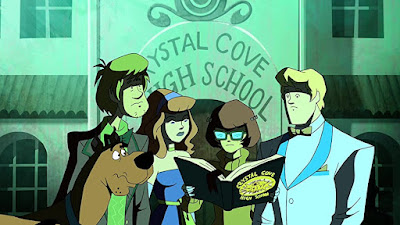The contrast between enchantment and disenchantment was popularized by Charles Taylor in his book A Secular Age, a contrast between a world once experienced as supernatural and miraculous to our modern world of unbelief and declining church attendance.
Hunting Magic Eels wasn't my first book about disenchantment. In my book Reviving Old Scratch: Demons and the Devil for Doubters and the Disenchanted, I described how disenchantment has affected how we think about evil. I called this process "ScoobyDooification."
In writing Reviving Old Scratch I wanted to talk about Rudolf Bultmann's notion of demythologization. According to Bultmann, the ancient cosmology of the Bible was mythological, as opposed to "scientific." These mythological components were taken to be unacceptable to modern, scientific people. And importantly for Bultmann, these mythological aspects of the Biblical story weren't critical to the "real" truths of the gospel, which Bultmann took to be existential and ethical, rather than metaphysical and supernatural. And so, Biblical scholars had to strip away the supernatural overlay to get at these existential and moral truths. Scholars had to demythologize the Bible, peel off the mythological, supernatural stuff that modern people could no longer believe to reveal the ethical core.
In writing Reviving Old Scratch, I didn't want to use the word "demythologization" or describe the work of German theologians. I didn't want the book to sound like an academic lecture. So I searched for a more whimsical and accessible way to describe demythologization. I came up with "ScoobyDooification."
You'll recall the first generation of Scooby Doo shows. Scooby and the gang show up in a town where some supernatural and spooky things are going on. The kids investigate, and suspicions grow that things in the town aren't quite what they appear to be. So the gang sets a trap for the ghost, spook, or monster. Upon catching the creature, they unmask it to reveal Mr. Jenkins the greedy banker who was using the monster to scare people away from noticing some criminal activity he was up to.
Basically, the early Scooby Doo episodes weren't just mysteries, they were stories debunking the supernatural. The plot line always moved from enchantment--There is a ghost!--to disenchantment: "Mr. Jenkins!" There wasn't any supernatural evil afoot, just human corruption and greed.
In Reviving Old Scratch, I describe how we increasingly approach the Biblical accounts of the devil and the demonic through ScoobyDooification. As rationalists and skeptics, we can't believe in the "mythological" accounts of the devil and demons we read about in the pages of Scripture. So we "demythologize" those stories, taking the devil to be a symbol and metaphor that points to human evils and oppressions. We are then called to fight these evils in the world. Again, notice how we are shifting here from metaphysics to ethics. You don't need to believe in the devil--the myth--but you are called to fight injustices in the world. What started with supernaturalism ends up with a purely human account. Just like the plotline of a Scooby Doo episode. We ScoobyDooify the devil, we demythologize.
And yet, things are not quite that simple. Not with the devil, not with disenchantment, and not with Scooby Doo.
Although Hunting Magic Eels is primarily interested in the challenge of disenchantment, the final section of the book turns to what has been called "the myth of disenchantment." As many have pointed out since the publication of Taylor's A Secular Age, the world remains very much enchanted. Most people are supernaturalists in some form or fashion. People believe in ghosts, life after death, reincarnation, paranormal phenomena, witchcraft, demons, the devil, gods, God, and on and on. True, organized religion is in decline, the culture is increasingly post-Christian, but people aren't opting for hard core atheism. We are, rather, dabbling in alternative enchantments in a very diverse metaphysical marketplace.
Even in a secular and skeptical age, we remain hungry for magic. And you see that in the subsequent installments and reboots of the Scooby Doo franchise. The original Scooby Doo was built around debunking the supernatural. Scooby Doo embodied a metaphysical skepticism. Scooby Doo was disenchanted. But that's no longer the case. Over the course of its history, Scooby Doo has moved from disenchantment to enchantment. Scooby and the gang now encounter real ghosts.
In tracing this history--and let me confess that I am no Scooby Doo historian--for the first ten years of the show the monsters were fake. But starting in the 1980s, real monsters started to appear in the Scooby Doo movies. In 1985, a big shift occurred with The 13 Ghosts of Scooby-Doo. In this series, Scooby and the gang had to help Vincent Van Ghoul capture thirteen of the scariest and most terrifying ghosts on earth. Subsequent installments of the show returned to the fake monsters, but the supernatural returned with the popular reboot Scooby-Doo! Mystery Incorporated, which aired from 2010 to 2013. Mystery Incorporated was noteworthy for introducing Lovecraftian themes into the franchise, and also introducing a story arc that linked the episodes. While each episode continued to feature a fake monster, the story arc was supernatural.
My point in sharing this history? Simply this: The "myth of disenchantment" doesn't just apply to our secular age. The "myth of disenchantment" also applies to Scooby Doo.
Like it or not, our world is durably spooky.


